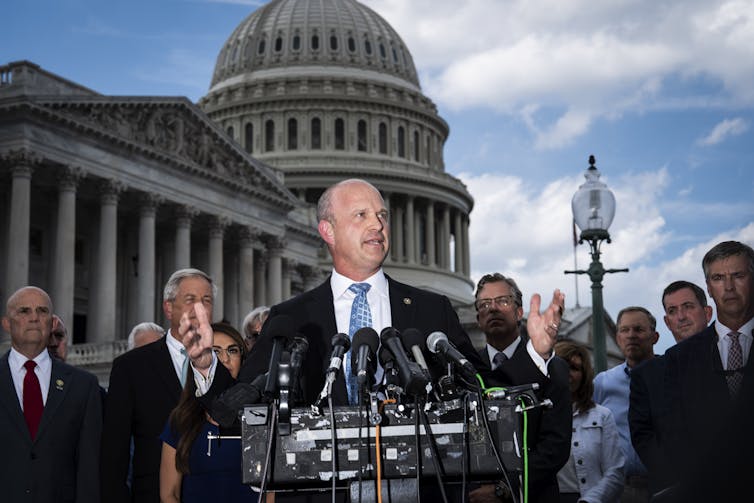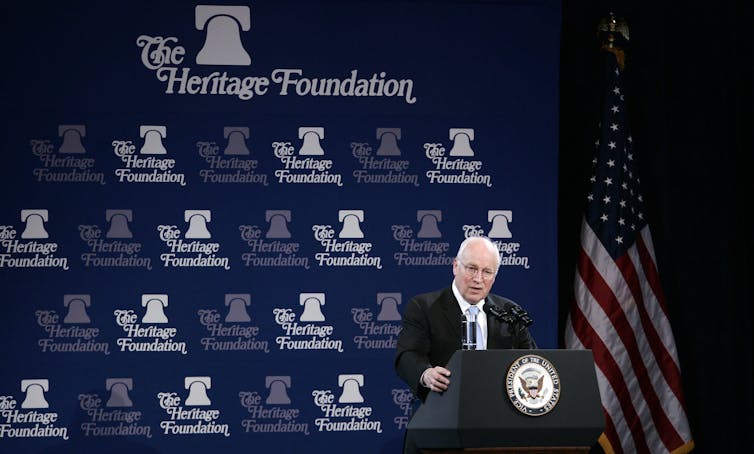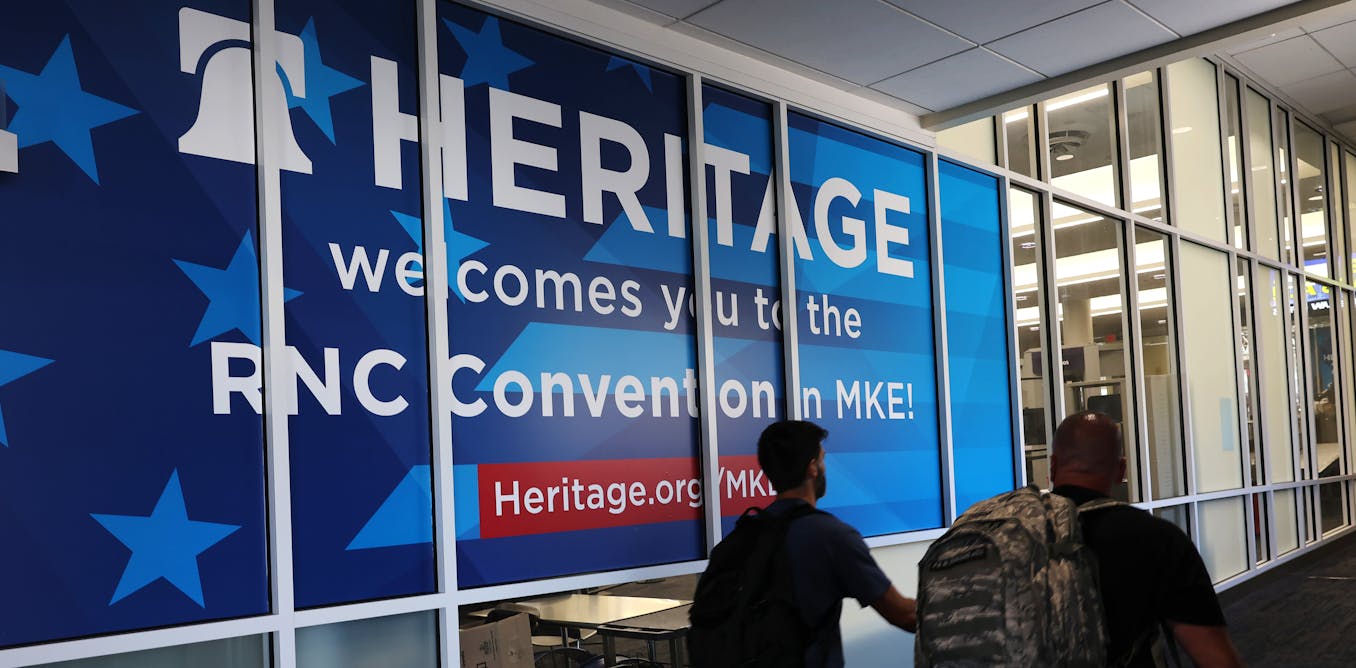As the 2024 presidential election heats up, some people are hearing about the Heritage Foundation for the first time. The conservative think tank has a new, ambitious and controversial policy plan, Project 2025, that calls for an overhaul of American politics and government.
The 2025 Project lays out many standard conservative ideas—such as prioritizing energy production over environmental and climate issues and rejecting the idea of abortion as health care—but also some much more extreme ones, such as criminalizing pornography. And it proposes abolishing or restructuring countless government agencies in line with conservative ideology.
While think tanks sometimes have a reputation for being stuffy academic institutions, detached from day-to-day politics, Heritage is quite different. Heritage was founded not only to develop conservative policy ideas, but also to advance them through direct political advocacy.
All think tanks are classified as tax-exempt 501(c)(3) organizations, which are barred from running in elections and can only engage in limited political lobbying. However, some, like Heritage, also form affiliated 501(c)(4) organizations that allow them to participate in campaigns and lobby extensively. Heritage is one of the sponsors of the Republican National Convention, which concludes in Milwaukee on July 18, 2024.
While researching my forthcoming book, Partisan Policy Networks, I discovered that a growing number of think tanks are explicitly ideological, aligned with a single political party, and directly advocating for political interests.
Still, Heritage stands out among all the groups I studied. It is much more conservative, and more closely aligned with the Republican style of former President Donald Trump. Heritage also more aggressively promotes conservative ideas, combining campaign spending with lobbying and large-scale grassroots mobilization.
Americans can expect to hear much more about these ideas, such as those outlined in Project 2025, if Trump is re-elected in November 2024.

Jabin Botsford/The Washington Post via Getty Images
A new kind of think tank
Two Republican congressional staffers, Ed Feulner and Paul Weyrich, founded Heritage in 1973 as an explicit rebuff to existing think tanks that they felt were either too liberal or too reticent in promoting conservative ideas.
Feulner and Weyrich were particularly outraged when the then leading conservative think tank, the American Enterprise Institute (AEI), published a policy report in 1971 on the question of whether to authorize government funding for supersonic transport aircraft capable of flying faster than the speed of sound. The AEI published its recommendations several days after Congress voted on the issue because it “did not want to try to influence the outcome of the vote.”
Heritage turns that philosophy on its head. Rather than conducting policy research for its own sake, Heritage conducts research, as one staff member told me in 2018, “to build arguments, to make arguments for policy change.”
For example, Heritage Action for America, a 501(c)(4) advocacy organization affiliated with Heritage, and Sentinel Action Fund, a super PAC it founded in 2022, spend money to influence elections and lobby elected officials on issues as diverse as taxes, abortion, immigration and the environment.
For this reason, some scholars and politicians refer to Heritage and other similar groups as “do tanks” rather than “think tanks.”
Because Sentinel Action Fund is a super PAC, it can raise and spend unlimited amounts of money to influence elections as long as it doesn’t coordinate with candidates’ campaigns. Sentinel Action Fund then spent more than $13 million on voter outreach and advertising in the 2022 midterm elections. The fund’s self-declared goal was to secure Republican majorities in the House and Senate by supporting “key conservative fighters” in “tough general elections.”

Jeff Haynes/AFP via Getty Images
People, not just money
But as my research shows, it is people, not money, that make Heritage influential.
Heritage has worked directly to place former and current employees in congressional offices and the executive branch. More than 70 former and current Heritage employees began working for the Trump administration in 2017—and four current Heritage employees were members of Trump’s Cabinet in 2021.
Heritage also says there are more than 2 million local, volunteer activists and about 20,000 “sentinel activists” who receive information from Heritage and participate in organized campaigns to push conservative policies. My interviews show that activists working with Heritage participate in strategy meetings, contact elected officials with coordinated messages, and spread the organization’s messages on social media.
In one 2021 example, the Heritage Foundation produced a report on voter fraud and voter integrity. Heritage Action for America, meanwhile, coordinated organizing volunteers to deliver that report to Georgia lawmakers, had staff meet with those lawmakers to advise them on passing new voting restrictions, and paid for television ads urging citizens to support such legislation.
Heritage, Trump and Project 2025
All of these efforts add up to enormous influence within the Republican Party. The legacy has played a key role in pushing Republicans toward more conservative policies since its founding.
When then-President Ronald Reagan took office in 1981, for example, the Heritage Foundation already had a ready-made conservative agenda for the new administration. By the end of his first term, Reagan had implemented over 60 percent of the think tank’s policy recommendations.
When Trump took office in 2016, Heritage was back with friendly staff and a practical policy program dubbed the “Blueprint for Reorganization.” By the end of Trump’s first year in office, Heritage boasted that he had “adopted 64 percent of our 321 recommendations,” including key conservative priorities like tax reform, regulatory cuts and increased defense spending.
Project 2025 is similar to these other recommendations for Republican politicians and presidential candidates. It outlines an agenda for a new president and a team of experts to help him achieve it.
But Project 2025 has taken a different direction compared to previous plans. Kevin Roberts, president of Heritage, described the group’s role as “institutionalizing Trumpism.”
This is likely why Project 2025 and Heritage have received such an unusual amount of attention in recent months. The fact that a 900-page, slanted policy memo has been the focus of countless news articles and hundreds of tweets from the Biden campaign, especially ahead of the 2024 election, is a clear indication of its expected influence.
The Trump campaign team, in turn, maintains distance from the project, as Trump himself has implausibly claimed that he knew nothing about it.
He’s probably staying away from Project 2025 because parts of its agenda are far too extreme for all but the most hardcore conservative activists. But even if Trump doesn’t campaign on these policies, Americans can expect Heritage’s ideas to play a big role in a second Trump administration. The Heritage Foundation was founded for this goal.




